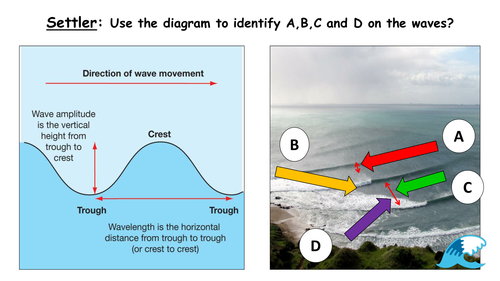Understanding Waves
- Get link
- Other Apps
Understanding Waves: Exploring the Nature of Wave Phenomena
Introduction:
Waves are ubiquitous in our world, manifesting in various forms and playing a fundamental role in numerous scientific disciplines. From the gentle ripples on a calm lake to the powerful sound waves that fill our ears, waves surround us and shape our experiences. In this article, we will delve into the fascinating world of waves, exploring their characteristics, properties, and real-life applications.
1. Defining Waves:
Waves can be broadly defined as disturbances that propagate through a medium, transferring energy from one location to another without causing any net displacement of the medium itself. While waves can take on many different forms, they all share certain common characteristics:
a. Amplitude: The amplitude of a wave refers to the maximum displacement or intensity of the wave from its equilibrium position. In simple terms, it measures the height or strength of the wave.
b. Wavelength: Wavelength is the distance between two consecutive points in a wave that are in the same phase. It is often denoted by the symbol λ (lambda) and is typically measured from crest to crest or trough to trough.
c. Frequency: Frequency represents the number of complete oscillations or cycles a wave undergoes per unit of time. It is measured in hertz (Hz) and is inversely proportional to the wavelength. The higher the frequency, the shorter the wavelength.
d. Period: The period of a wave is the time it takes for one complete oscillation to occur. It is the reciprocal of the frequency and is typically denoted by the symbol T. The period and frequency of a wave are mathematically related as T = 1/f.
2. Types of Waves:
Waves can be classified into different categories based on various factors, including the nature of the medium and the direction of particle oscillation:
a. Mechanical Waves: Mechanical waves require a medium, such as air, water, or solids, to propagate. Examples include ocean waves, sound waves, and seismic waves (earthquakes).
b. Electromagnetic Waves: Electromagnetic waves can propagate through a vacuum and do not require a medium. They include visible light, radio waves, microwaves, infrared radiation, ultraviolet radiation, X-rays, and gamma rays.
c. Transverse Waves: In a transverse wave, the particles of the medium oscillate perpendicular to the direction of wave propagation. Examples include water waves and electromagnetic waves.
d. Longitudinal Waves: In a longitudinal wave, the particles of the medium oscillate parallel to the direction of wave propagation. Sound waves are an example of longitudinal waves.
3. Wave Behavior and Principles:
Waves exhibit various behaviors and follow fundamental principles that govern their propagation and interactions:
a. Reflection: Reflection occurs when a wave encounters a boundary or obstacle and bounces back. The angle of incidence is equal to the angle of reflection, following the law of reflection.
b. Refraction: Refraction happens when a wave passes from one medium to another, causing a change in its direction and speed. This bending of the wave occurs due to a change in the wave's velocity as it crosses the boundary.
c. Diffraction: Diffraction refers to the bending or spreading out of waves when they encounter an obstacle or pass through an opening. It occurs when waves encounter an obstacle with a size comparable to their wavelength.
d. Interference: Interference occurs when two or more waves meet and combine. Constructive interference happens when waves are in phase and reinforce each other, resulting in a wave with increased amplitude. Destructive interference occurs when waves are out of phase and cancel each other out, resulting in a wave with decreased amplitude.
e. Superposition: The principle of superposition states that when two or more waves overlap, the resulting displacement at any point is the algebraic sum of the individual wave displacements.
4. Applications of Waves:
The understanding and application of wave phenomena have revolutionized numerous fields, leading to technological advancements and practical applications:
a. Communication: Waves, particularly electromagnetic waves, form the basis of modern communication systems. Radio waves, microwaves, and optical fibers are used for wireless communication, satellite communication, internet connectivity, and more.
b. Medical Imaging: Waves, such as X-rays, ultrasound, and magnetic resonance imaging (MRI), are utilized in medical diagnostics and imaging techniques. They allow healthcare professionals to visualize internal structures and detect abnormalities.
c. Acoustics: The study of sound waves and their behavior in different environments is essential in fields like music, architecture, and noise control. Acoustic engineering focuses on optimizing sound quality, designing concert halls, and reducing noise pollution.
d. Seismology: Seismic waves generated by earthquakes provide valuable information about the Earth's interior structure. Seismologists study these waves to understand plate tectonics, predict earthquakes, and mitigate their impact.
e. Optics: Optics deals with the behavior and manipulation of light waves. It encompasses various applications, including photography, microscopy, laser technology, and fiber optics.
Conclusion:
Waves are captivating phenomena that shape our understanding of the natural world and have far-reaching implications in science, technology, and everyday life. Whether it's the transmission of information through electromagnetic waves, the diagnostic capabilities of medical imaging techniques, or the enchanting melodies of music, waves surround us and play a vital role in our experiences. By understanding the nature of waves, their properties, and behaviors, we can unlock their potential and continue to explore their applications in various fields of study.
- Get link
- Other Apps

Comments
Post a Comment